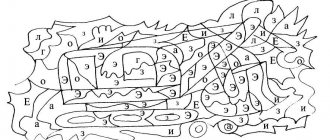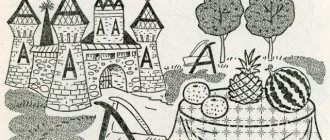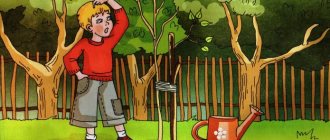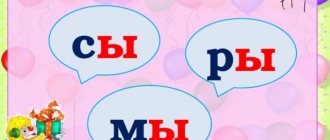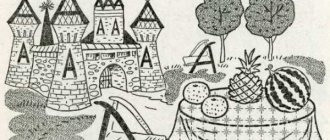Sound and letter T. Literacy lesson in the preparatory group
Municipal budgetary preschool educational institution "Kindergarten of general developmental type "Batyr" of the city of Buinsk, Buinsky municipal district of the Republic of Tatarstan"
Summary of
an open lesson on teaching literacy in the preparatory group “Sound and letter T”
Teacher of the first qualification category: Kashapova G.S.
2015 Goal: to consolidate the articulation and characteristics of the sound
“ T ”; develop phonemic hearing, attention and memory; practice sound-letter analysis and synthesis of words. Introduce the letter “ T ”, read the syllables.
Guys, today we will go on a journey through the “Land of Knowledge”. But first, let's remember what letters we already know? In order, name the letters and words you already know, in which this sound will come at the beginning. (A-watermelon, U-duck, O-glasses, M-mom, S-catfish, H-leb, R-crayfish, Sh-ball, Y-smoke, L-lemon, N-rhino, K-cat)
- Now tell me, into what groups are all the letters and sounds divided?
- (Vowels and consonants, hard and soft).
So, let's hit the road. Music (We're going, we're going...)
- The first stop is called "Sound"
- What sound is repeated in the words: cat, stomp, desk, cake (Sound “T”)
- Let's make the "T" sound
- What does our tongue do when we pronounce the sound “T” (knocks on the tubercles)
- Do you feel a stream of air rushing out?
- Let's try to sing the sound "T" (not sung)
- So what is the sound of "T"? (consonant)
Game "Passengers"
- You have pictures on the tables, they are rushing to catch the train, put them in the appropriate carriages: 1st carriage - the sound T at the beginning of the word;
2nd car - T sound in the middle of a word; 3rd car - T sound at the end of a word. Physical education session
We're a little tired, let's rest for a minute. Turn, tilt, jump, Smile, come on my friend, Keep your back straight, Look at your neighbor, Hands up and immediately down And get on the bus..
- We are traveling further through the land of knowledge. Music
Stop “Acquaintance with the letter T” I hang the letter “T” on the board.
- What elements does the sound T consist of? Let's make the letter “T” from sticks.
- What does he look like?
The hammer knocks: “Knock-Knock!” To the letter T I am an old friend. Finger gymnastics.
Fingers do exercises To get less tired And then they will write letters in a notebook Graphic dictation: 6 cells up, 2 cells to the left, 1 cell up, 5 cells to the right, 1 cell down, 2 cells to the left, 6 cells down, 1 cell to the left. Let's move on Music. Stop "Magic Clock". Educator. Read the syllables where the arrow stopped: at, ut, from, uat, ta, tu, then; Words: here, that, there, that, sweat, Tom. Game “Clever girls and smart guys” Pronouncing pure sayings: Ta-ta-ta - our house is clean. You-you-you - the cats ate all the sour cream. That's it - we started playing lotto. At-at-at- we take a scooter with us. Whoops, we're going for a walk. You guys are great! You had a great time today, and most importantly, it was useful.
- What sound were you introduced to in class?
- What does the letter look like?
The lesson is over
Target.Clarify the articulation of sounds [t—t'], practice their differentiation; consolidate the ability to determine the sequence of sounds in monosyllabic words; expand children's vocabulary with antonym words; work on the generalized meaning of words; familiarize children with the image of the letter Tt; consolidate images of letters; prepare your hand for writing.
Equipment.
Mirrors, a diagram for analyzing articulatory sounds, a set of pictures, sound houses, panels of letters, sheets of paper with images of double lines, pencils; scissors and cut out letters according to the number of children.
Progress of the lesson
I. - Today we will meet two boys. Their names are Tim and Tom. Let's determine how many syllables and what sounds are in their names.
Tim - O. The first sound is [t'], the second is [i], vowel, the third is [m], consonant, hard.
Tom - Oh, the first sound is [t], the second is [o], vowel, the third is [m], consonant, hard.
The teacher asks to repeat the first sounds in the boys' names ([t1] and [t]).
“Today we will get acquainted with these sounds.”
II. 1 . Articulation of sounds.
Analysis according to the scheme.
The lips are slightly open, the teeth are open, the tip of the tongue when pronouncing the sound [t] closes with the upper teeth, when pronouncing the sound [t'] the tip of the tongue is lowered and rests on the lower teeth, the vocal cords do not vibrate.
Characteristics of sounds.
The sounds [t-t'] are consonants, there are soft and hard.
III. 1. Differentiation of sounds [t—t'] in the game “Replace the sound.”
Tim liked words with a soft sound [t'], and Tom liked words with a hard sound [t]. As soon as one pronounces a word with a hard sound [t], the other immediately replaces it with a soft [t']. And vice versa. For example: brother
-
take.
Which word did Tim say and which did Tom say? Why do you think so?
Tom said the pole,
and Tim - ...
(six).
Tim said tough
and Tom - ...
(gesture).
The teacher draws attention to the fact that as the sound changes, the meaning of the words changes. Asks to explain the meaning of words and make sentences with them.
Game “It was and became” for the use of antonym words.
— When Tom and Tim were little, their parents planted a poplar tree in the yard. The boys loved this tree very much. They were growing. The poplar also grew. Tim and Tom often remembered what he was
poplar, and were proud, looking at him, of what he had become.
I will talk about the poplar when it was a seedling. And you will choose a word with the opposite meaning and say what he has become now.
The poplar was thin
became... (fat);
was low,
became...
(tall);
was
young,
became... (old).
There were few branches ,
there were ... (many).
The branches were short,
they became ...
(long).
The bark was
smooth,
but became
... (rough).
The leaves were
small,
became
... (large),
were
wet,
became ... (dry), were
light,
became ...
(dark).
4. Work on the generalized meaning of words (transport).
— Tom and Tim lived in a big city. They knew all the city transport. And the word transport
Tom especially liked it. Why? (What are the first and last sounds in this word?)
Children, what city transport do you know? (Tram, trolleybus, taxi, bus, metro)
The teacher asks to determine the place of the sound [t] in all words.
- Which of the boys liked all these words? (To that. In all words the sound [t] is hard)
IV. 1. Introducing the letter Tt.
The sounds [t—t'] in the letter are indicated by the letter Tt, who lives at the address: second floor (second row from the bottom), apartment No. 4 (fourth cell from the left).
2. Analytical and synthetic activity (using scissors and a letter constructor).
V. Exercise “Tram” to prepare your hand for writing. Practice drawing lines (from left to right), trying not to take your hands off the sheet and not to go beyond the intended contour.
Double winding lines (tram rails) are depicted across the entire area of the sheet. The lines are continuous.
— These lines are tram rails. You will walk the entire route by drawing a pencil line inside the rails. And you should not go beyond the contours of the lines.
The tram must quickly transport passengers from the city (symbol: house) to the park (symbol: Christmas tree). Therefore, your trams are allowed not to make stops. But if your arm gets tired, you will stop and mark it with a circle.
Note.
Analysis of the performance of this task will help educators establish individual differences in the muscular endurance of children’s arms. In accordance with the results obtained, teachers plan individual work with children.



